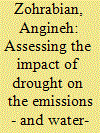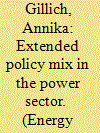|
|
|
Sort Order |
|
|
|
Items / Page
|
|
|
|
|
|
|
| Srl | Item |
| 1 |
ID:
166432


|
|
|
|
|
| Summary/Abstract |
This article examines China's Electric Power Law and the recent policies governing China's electricity sector from the energy-climate-environment dimension. Using the fragmented authoritarianism framework, it captures the legal system that is still rooted in the pre-reform era, and the antinomic policy making that is driven by the policy imperative to accommodate the shifting pattern of energy supply, the growing awareness over climate mitigation and environmental protection. By examining the most recent policy imperatives on regulating new investment and efficiency, and pricing deregulation, this article focuses on changes in the policy arena and their impacts on the regulatory governance of China's electricity sector. Using the methodology of qualitative study, this article critically investigates these policy changes that generate incompatible regulatory concerns. The incompatibility creates competing regulatory concerns over energy-climate-environment in the policy making process, and generates discord between China's central and provincial governments. Dealing with the challenges will depend on developing a legal framework for China's electricity sector. Findings of this article echoes with energy law scholars’ point of view that energy law has a much bigger role to play to balance different or competing policy agendas to deliver better energy policy that delivers the expected outcomes for society.
|
|
|
|
|
|
|
|
|
|
|
|
|
|
|
|
| 2 |
ID:
171377


|
|
|
|
|
| Summary/Abstract |
Saudi Arabia relies heavily on oil-based generation to meet its power needs within a geographically unbalanced pattern of natural demand and supply. Many initiatives are currently being assessed to reduce the high opportunity cost of burning oil for the country. This paper examines the cost and implication of a disruptive policy where Saudi Arabia imports liquefied natural gas (LNG). To determine the possible and optimal sources to procure LNG into Saudi Arabia we use and configure a partial equilibrium model, specified as a linear programming problem. Two import scenarios were tested: the first assumes an import terminal with a capacity of 5 million tonnes per annum (MTPA) and the other scenario assumes 22 MTPA. Results show that Saudi Arabia can import LNG for power generation at a discount to the opportunity cost of oil. Especially during the summer months, as Saudi Arabia's gas demand is counter-seasonal to major importing regions it leads to even more interesting market pricing conditions. It also shows a small difference in landed cost of LNG between the two scenarios which implies the global LNG market can accommodate relatively large demand from Saudi Arabia without distorting significantly the global market pricing mechanism.
|
|
|
|
|
|
|
|
|
|
|
|
|
|
|
|
| 3 |
ID:
162327


|
|
|
|
|
| Summary/Abstract |
This study investigates how technological transitions across California's power sector have shifted its state-level carbon dioxide emissions and cooling water consumption intensities. Its ultimate goal is to evaluate how the state's climate mitigation and environmental policies have affected the power sector's vulnerability to extreme drought and how extreme drought has affected progress towards the state's climate mitigation priorities. The study analyzes the period spanning 2010–2016, which includes one of the state's most severe droughts on record. The results indicate that the growth of variable renewable energy generation has helped offset some of the negative consequences of drought, which include increased emissions and cooling water usage by natural gas generators during periods of low hydropower. However, the retirement of the San Onofre nuclear power plant has delayed the overall decarbonization of the state's power sector, and the closure of significant coastal power plant capacity could increase the freshwater consumption of the power sector if replacement capacity is not cooled with alternative cooling water sources or dry cooling systems. The noted tradeoffs between greenhouse gas mitigation priorities, freshwater dependency, and vulnerability to climatic events highlight the importance of holistic decision making as regional power grids transition to cleaner generation sources.
|
|
|
|
|
|
|
|
|
|
|
|
|
|
|
|
| 4 |
ID:
127211


|
|
|
|
|
| Publication |
2014.
|
| Summary/Abstract |
This paper critically screens 153 lifecycle studies covering a broad range of wind and solar photovoltaic (PV) electricity generation technologies to identify 41 of the most relevant, recent, rigorous, original, and complete assessments so that the dynamics of their greenhouse gas (GHG) emissions profiles can be determined. When viewed in a holistic manner, including initial materials extraction, manufacturing, use and disposal/decommissioning, these 41 studies show that both wind and solar systems are directly tied to and responsible for GHG emissions. They are thus not actually emissions free technologies. Moreover, by spotlighting the lifecycle stages and physical characteristics of these technologies that are most responsible for emissions, improvements can be made to lower their carbon footprint. As such, through in-depth examination of the results of these studies and the variations therein, this article uncovers best practices in wind and solar design and deployment that can better inform climate change mitigation efforts in the electricity sector.
|
|
|
|
|
|
|
|
|
|
|
|
|
|
|
|
| 5 |
ID:
150727


|
|
|
|
|
| Summary/Abstract |
Over the last decades, electricity markets across OECD countries have been subjected to profound structural changes with far-reaching implications on the economy and the environment. This paper investigates the effect of restructuring – changes in entry regulations, the degree of vertical integration and ownership structure – on GHG emissions. The findings show that competition policies – particularly reducing the degree of vertical integration and increasing privatization – correlate negatively with emission intensity. However, the environmental effect of reducing market entry barriers is generally insignificant. Integration of competition and stringent environmental policies are required to reduce GHG emissions and improve environmental quality.
|
|
|
|
|
|
|
|
|
|
|
|
|
|
|
|
| 6 |
ID:
177107


|
|
|
|
|
| Summary/Abstract |
With the phase-out of coal power plants, the existing mix of instruments aimed at decarbonising electricity sectors is getting more complex. This paper contributes to its understanding by highlighting the impact of coal phase-out, CO2-price and increasing capacity of variable renewable energies on contribution margins of power plants. By visualizing these three instruments in a brownfield screening curves model (SCM), their fundamental effects on plant operation, electricity price and margins become apparent at a glance. Moreover, the SCM allows to derive generic statements about winners and losers on the supply side. Results are then quantified within a case study for Germany using the power sector model E2M2. The high resolution regarding time and generation system permits a realistic simulation of electricity prices and thus of margins at plant level.
|
|
|
|
|
|
|
|
|
|
|
|
|
|
|
|
| 7 |
ID:
150625


|
|
|
|
|
| Summary/Abstract |
European Union carbon emissions allowances (EUA) price fluctuations can affect electricity companies' stock market values as these oscillations may change firms' profitability and thus investors' decisions. This outcome can differ not only contingent on the EU ETS Phase, but also on firms' generation mix. Moreover, stock markets may react differently to EUA increases in comparison to decreases, thus asymmetrically.
|
|
|
|
|
|
|
|
|
|
|
|
|
|
|
|
| 8 |
ID:
176814


|
|
|
|
|
| Summary/Abstract |
Environmental and technical efficiency in the electricity sector is a major focus of regulatory policies aimed at hastening greenhouse gas reduction and lowering energy prices for final consumers. Understanding the impact of market and environmental regulations on efficiency is crucial for the design and choice of policy packages. At the national level, the productivity response to regulations depends on unobserved country-specific factors that current empirical analyses have not modelled. In this framework, we analyse the regulation effects on efficiency in the electricity sector for a panel of European Union countries. We explicitly consider the effects of the environmental regulation along with the market regulation. Our estimation strategy uses the Bayesian shrinkage estimator, which can deal with the bias aggregation problem and cross-country heterogeneity. It allows us to identify the different transmission channels through which regulatory policy is implemented. The results highlight divergent behaviours at the country level. The direct impacts of the market and environmental regulatory policies on productivity are negative—around −2.7% and −2.3%, respectively—but the countries vary in the degree to which they are able to compensate these negative effects.
|
|
|
|
|
|
|
|
|
|
|
|
|
|
|
|
| 9 |
ID:
169902


|
|
|
|
|
| Summary/Abstract |
Despite progresses achieved in several directions, Indian electricity sector continues to suffer from multiple anomalies that might endanger the energy security of the country. It is pertinent at this juncture to ask the question whether the sector is moving on a sustainable growth trajectory. Using a sustainable development framework, the present study evaluates how sustainable the Indian electricity sector is. It employs 11 indicators representing three dimensions of sustainable development i.e. economic, environmental and social and analyses 12 Indian states over a decade period. The findings of study suggest that the sector is moving towards sustainability though deviations exist in the performance of individual states and individual dimensions.
|
|
|
|
|
|
|
|
|
|
|
|
|
|
|
|
| 10 |
ID:
126624


|
|
|
|
|
| Publication |
2013.
|
| Summary/Abstract |
This paper discusses policy instruments for redirecting technical change within the electricity sector to mitigate climate change. First, we unravel the mechanism behind directed technical change, explaining why markets may underprovide innovations in expensive renewable technologies in comparison to innovations in energy-efficient fossil-fuel generators. Subsequently, we characterize technical change in electricity generation technologies, stressing the heterogeneity of knowledge spillovers both within and between clean electricity generation technologies. We argue that there exists a rationale for a portfolio approach to innovation in the electricity sector, i.e., optimal innovation policies are neither fully generic nor fully specific; and they need to be adapted, in response to new information learned by the government. The existing innovation literature does not, however, provide a clear-cut answer for designing such a policy. We compare policy instruments and argue that public R&D support to clean technologies, either in the form of subsidies or prizes, seems to be the prime candidate for implementing non-generic innovation policy.
|
|
|
|
|
|
|
|
|
|
|
|
|
|
|
|
| 11 |
ID:
127297


|
|
|
|
|
| Publication |
2014.
|
| Summary/Abstract |
This article employs the multi-level perspective on socio-technical transitions to explore the historical evolution of the electricity regime in the province of Ontario from 1885-2013 and to interpret the potential for future movement towards decarbonization. With an emphasis on the political and social dimensions of transitions, this analysis traces the key features influencing change within Ontario's electricity system over the past century. This paper uses multiple criteria (the phase of electrification; role of the electricity system in economic development; structures of ownership, market and regulation; dominant technologies; and the relative stability of arrangements) to characterize distinct regime configurations and periods of instability which separate relatively stable system orientations. Lessons are drawn from the historical case with implications for future decarbonization in the province, including the importance of: (1) residual momentum; (2) embedded guiding principles; and, (3) Politico-Economic Coalitions.
|
|
|
|
|
|
|
|
|
|
|
|
|
|
|
|
| 12 |
ID:
181439


|
|
|
|
|
| Summary/Abstract |
As one of the important measures for China's power system reform, the electricity bidding pricing (EBP) is helpful to realize the effective allocation of power resources. Based on price conduction theory and complex network modeling technology, we construct the price transmission network for the 76 economic sectors in China, identify the critical path of electricity price transmission, and empirically simulate and analyze the economic impact of EBP in different scenarios from the two aspects of whether the CEPL mechanism is implemented or not. The results indicate that the electricity price will be decreased directly by the EBP, and the electricity industry will significantly reduce the impact on other related industries. Particularly, affected by regulatory policies such as electricity price cap, the electricity price caused by EBP cannot be effectively transmitted to the upstream industries. Secondly, with the simultaneous implementation of the coal-electricity price linkage (CEPL) and the EBP, the coal-electricity price transmission will change from one-way conduction style to two-way interaction style, and the impact of electricity price fluctuations on its related industries will be more significant, while the comprehensive impact of the coal industry on its associated industries will be significantly reduced. Thirdly, there are obvious scenario differences in the impact of different intensity of EBP on the macro-economy. The results show that under the mechanism of CEPL, the EBP with 20% of the total power used for bidding pilot has minimal impact on the Chinese economy. Based on the above conclusions, we propose that China should scientifically determine the scale and the pilot regions of electricity bidding under the CEPL, develop more diversified bidding forms and improve more robust supervision system.
|
|
|
|
|
|
|
|
|
|
|
|
|
|
|
|
| 13 |
ID:
139563


|
|
|
|
|
| Summary/Abstract |
Both supply- and demand-oriented solutions are important in cleaning up the electricity sector. However, their successful deployment calls for the removal of various barriers. This paper looks at China's electricity industry, one of the world's largest emitters of greenhouse gases, by relating the regulatory framework to the environmental dimension of sustainable electricity development. It develops an analytical framework by drawing upon the literature on the deployment of supply- and demand-side solutions, regulatory governance, and environmental policy integration. The paper finds that, in China's electricity sector, environmental considerations are subordinate to economic and development goals in policymaking and enforcement. Under the current regulatory framework, regulatory policies/instruments are not conducive to removing barriers to the effective deployment of the solutions.
|
|
|
|
|
|
|
|
|
|
|
|
|
|
|
|
| 14 |
ID:
171745


|
|
|
| 15 |
ID:
166493


|
|
|
|
|
| Summary/Abstract |
In Australia, as elsewhere, household electricity infrastructure is changing: over one-fifth of Australian households have rooftop solar photovoltaics (PV), and there is growing opportunity to purchase household battery storage. Australia has the highest proportion of distributed (household-level) solar PV worldwide. There is, however, concern from Australian utilities and governments that increasing numbers of households will opt to leave the centralised electricity grid, as it becomes technically feasible and cost-effective for them to do so. In this paper we explore the motivations and decision making of off-grid households, through a case study of the State of Tasmania, Australia. Our empirical research involved identifying existing sources of off-grid data and undertaking a survey and interviews of off-grid households. We conceptualise off-grid households as an instance of scarce data – a contrast to the concept of big data. Drawing on insights from critical data studies, we show how scarce data can act as a barrier to effective governance, with energy policy making skewed towards governing data-rich policy areas.
|
|
|
|
|
|
|
|
|
|
|
|
|
|
|
|
|
|
|
|
|